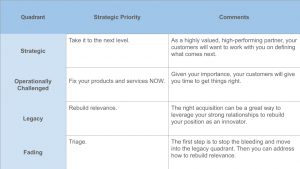Why? It’s the question that reveals your purpose and outlines why the work of your company matters. While the world around us is ever-changing. Ideally, purpose is enduring. And, just as importantly, Deloitte has found that purpose impacts an organization’s performance and long-term success. If that is the case, do you need a way to measure your WHY, and if so, what measures should you use?
Purpose is worthy of measurement, so the answer to the first question is yes. And yes, you need measures for your WHY that extend beyond customers. Your WHY impacts various stakeholders in your business – from employees and shareholders to suppliers and partners to industry and community associates.

Measure Your Purpose in Your Ecosystem
How your WHY impacts your ecosystem is reflected in a variety of ways: financial measures such as profit, revenue, and share price; customer measures such as engagement, preference, purchase intent, loyalty, and market share; employee measures such as recruitment, retention, and engagement; and discoverability measures such as brand sentiment, perception, and influence among suppliers, partners, and the community.
That’s a lot of measures! Perhaps you’re wondering if there a single metric we can use. This is something various people have explored. Two worth mentioning are Afdhel Aziz, the author of The ROI of Purpose, who explored how to take a holistic approach to purpose, and the Boston Consulting Group (BCG), who has examined purpose and its impact on long-term performance. BCG found that there is a strong relationship between purpose and Total Shareholder Return (TSR), as long as the purpose is clear, compelling, and inspiring to customers and employees, aligned to the company’s strategy, and integrated into the company’s decision making. This requires creating a fairly complex model. Is there a simpler way to measure for purpose?
Figure Out Why You Are Favored
Our work suggests that creating a measure around favorability can be linked to purpose. Participants in an ecosystem tend to favor organizations whose purpose is motivating, well-defined, and aligned. Some customers ask, “Can’t we just use preference, aren’t they same?” They are related, but not the same.
Preference suggests a position of choice when it comes to purchase, and as such, is an excellent measure of customer sentiment. Favorability, however, extends beyond purchase to encompass the feelings of ALL members of the ecosystem. In this way it is a more comprehensive measure of purpose than preference.

Not sure if people understand your WHY? Here’s two ways to do a quick check. Ask employees, partners, and existing customers. Check to make sure employees are clear about the WHY. Reinforce your WHY with every employee and partner. These are your ambassadors and front line. Second, leverage your customer advisory. Customer advisory boards provide an excellent vehicle for gaining insight into this type of question.
Once you have this information, address any gaps. Develop a plan to integrate your WHY across your organization and ecosystem. Decide how you will measure purpose and its impact on your organization. Initiate your measurement and monitor how well your WHY is being embraced and its contribution.
Business & Finance Articles on Business 2 Community
(50)
Report Post




